Research report by HRI researchers for “Hitachi Souken” Journal
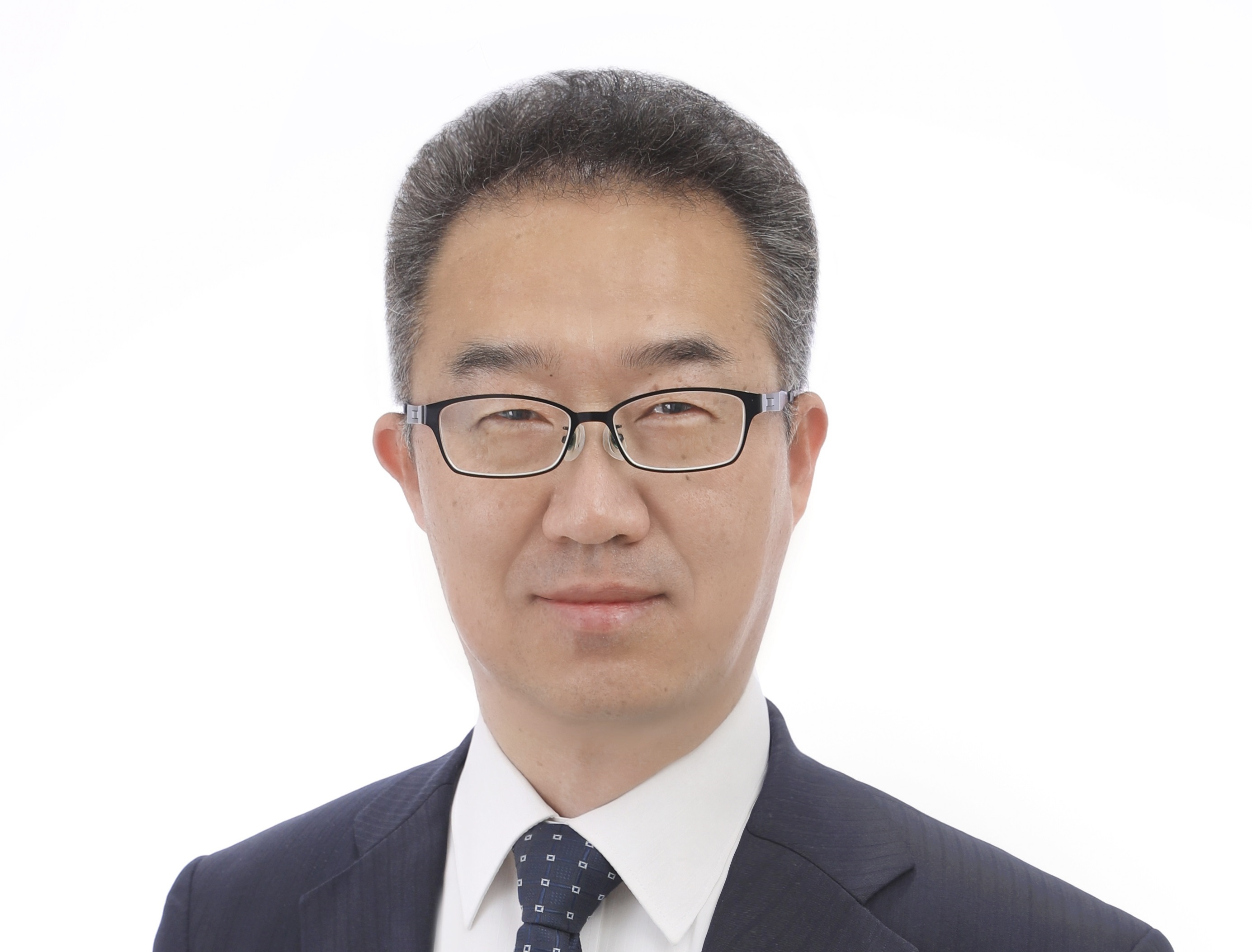
Kenichi Suzuki
Hitachi Research Institute
Chief Researcher, 1st Research Department
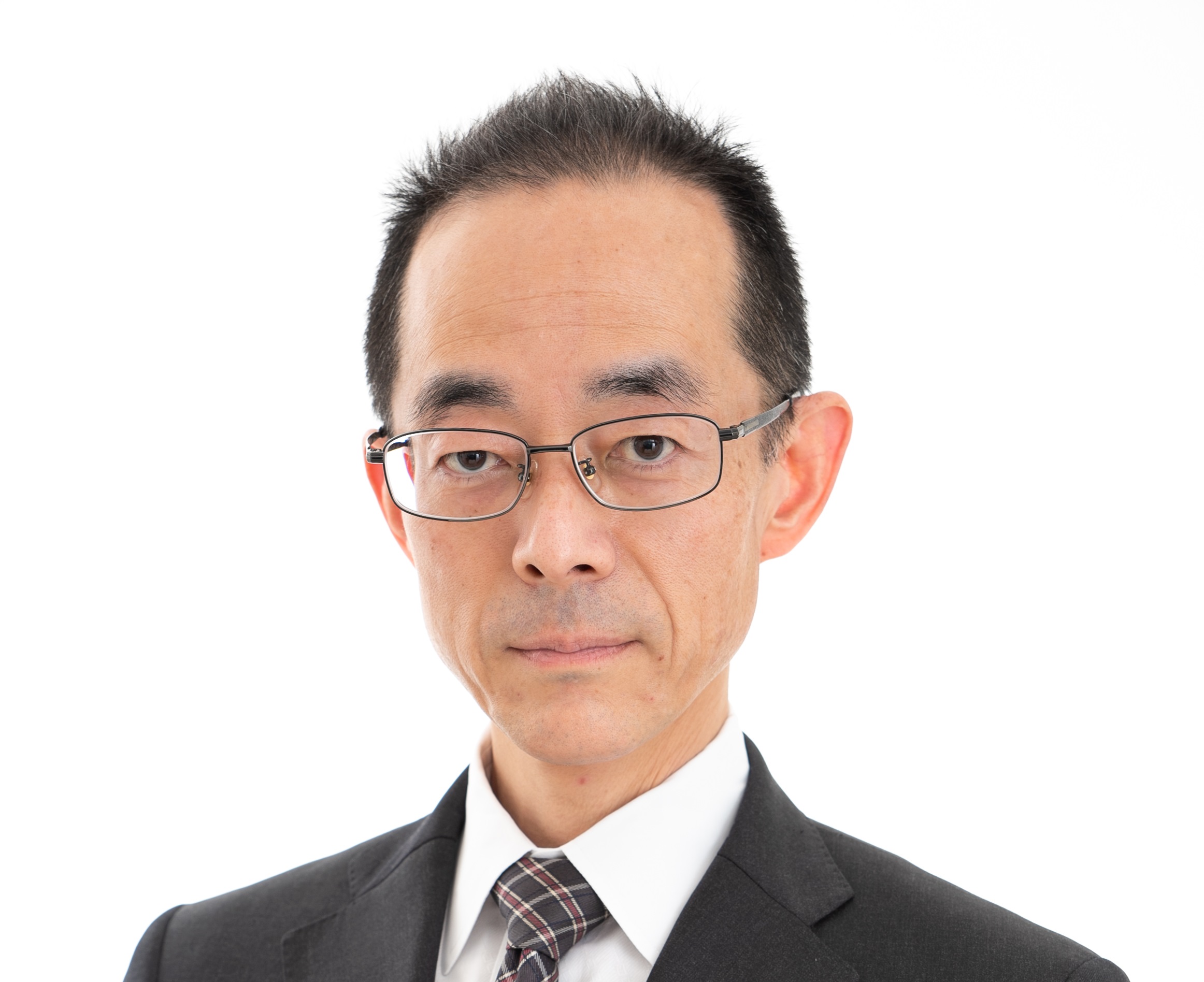
Naohiko Masuda
Hitachi Research Institute
Senior Researcher, 3rd Research Department
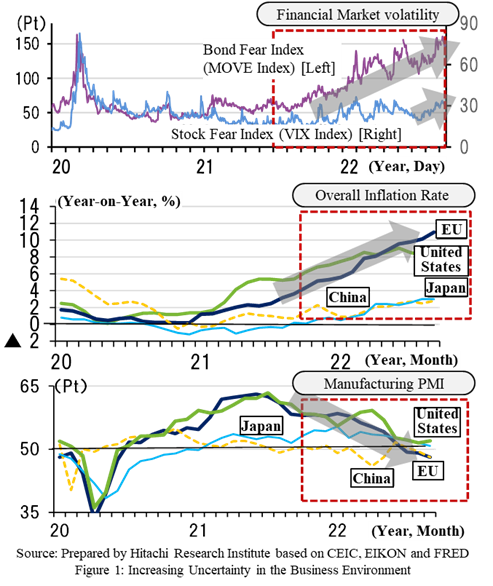
The environments surrounding businesses have changed significantly in the past few years and uncertainty about the future has increased at the same time, with the globalization and digitalization of the economy, our entry into the era of the 100-year life, the COVID-19 pandemic, and the Russian invasion of Ukraine, among others. Amid these circumstances, changes in market conditions seen over the past three years show expansion of the fear indexes (MOVE Index and VIX Index) measuring financial market volatility. Inflation has also been on the rise and the manufacturing sector PMI, which serves as an expression of the state of the economy, has deteriorated (Figure 1).
A look at the distribution of the market capitalization growth rates of 4,000 companies from developed world, however, shows that despite the presence of highly uncertain environments, there are some “Persistently growing companies” that are growing at an average of 25% annually (Figure 2).
An analysis of the growth factors of these persistently growing companies reveals the superiority of three major management perspectives. The first one has them expanding their business revenues by continuously bringing new products and services to market. The second one has them speeding up cash cycles through business model transformations involving elements such as subscriptions. The third one has them making improvements to the efficiency of their business assets, such as tangible fixed assets, by strengthening long-term and ongoing relationships with customers and building strong customer bases (Figure 3).
There is no single, absolute thing when it comes to efforts serving to support the superiority of these corporate management perspectives and initiatives serving to support cash growth. There are multiple elements at play, such as the promotion of R&D investments and the revamping of business portfolios. The strengthening of investments in human capital also serves as one of the important elements for that. To be specific, (1) in order to continuously bring new products and services to market, it is important to train and acquire specialized personnel, as well as to organically connect the skills possessed by these human resources, and (2) when it comes to transforming business models into ones such as those involving subscriptions, it is important to focus the attention of each employee on customers in order to quickly respond to customer needs, including back office operations. Furthermore, (3) when it comes to building stronger relationships with customers, it is important to increase employee engagement so that employees are able to develop a sense of unity based on the company’s purpose and management vision. In the following chapter onward, we will examine the direction of HR strategies that Japanese companies should adopt in the future by looking at examples of overseas companies that are undertaking advanced initiatives when it comes to these three measures aimed at the strengthening of human capital.
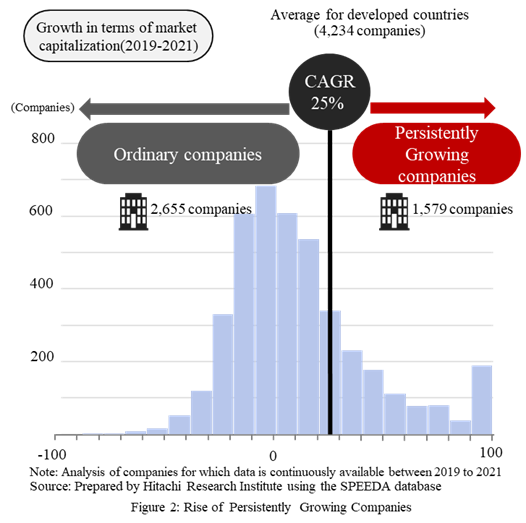
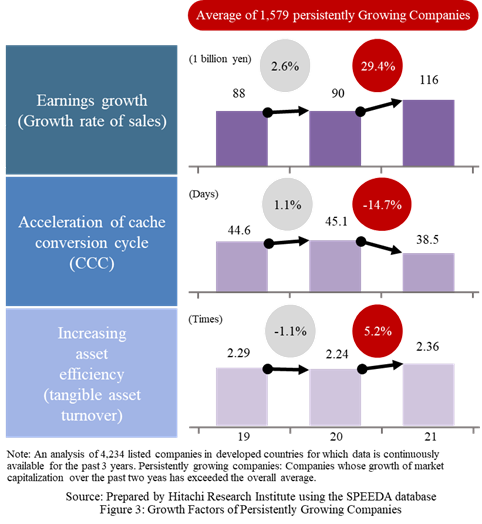
In response to changes taking place in terms of industry structures in association with the progression of DX and GX, as well as the intensification of global competition taking place across industries and in new industry sectors, Japanese companies are putting their energy into training and acquiring specialized personnel. In January 2020, the Japan Business Federation (Keidanren) proposed the introduction of job-based employment. Currently, many large companies and others are looking into overhauling their HR systems, which includes the formulation and revision of job descriptions. One of the problems facing Japanese companies, however, is that even if progress has been seen in terms of the recruitment of specialized personnel through the deployment of job descriptions, delays are being seen when it comes to creating mechanisms which serve to organically connect specialized personnel. For instance, the periodic reshuffling of personnel that has become customary at Japanese companies has also resulted in the reassignment of employees to jobs where their skills are not fully utilized. That is where a divergence is seen between the possession of skills and the use of skills, which leads to a decline in employee motivation. This serves as a factor which inhibits synergy among specialized personnel. When it comes to putting human capital management into practice, which serves to organically connect specialized personnel, it is important not only to enhance the acquisition and development of specialized personnel, but also to ensure “cross-departmental collaboration of specialized personnel.” It serves to contribute to the creation of added value for the company by having the entire organization function better with the stockpile of abilities and skills possessed by specialized personnel as input for its operations.
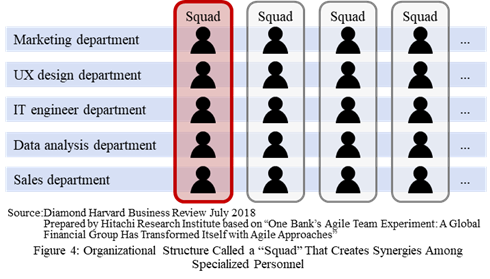
ING, a global financial group that is expanding its service offerings for individual customers through mobile apps, has successfully restructured its organization by implementing agile methods for a total of 3,500 people in each retail department, including marketing, UX design and IT engineers. The bank’s customers spend most of their time online using digital platforms like Facebook and Netflix. These services constitute the standard in terms of the value recognition in their daily lives. As such, ING had to be faster and more customer-focused when it came to financial services provided to the more than 30 million customers it has worldwide. For that purpose, ING introduced an agile method for new service proposals and development, wherein specialized personnel working in sales, marketing, data analysis, UX design, and other areas meet for meetings called “scrums” every morning at a fixed time to consult with each other while standing up (called “stand-ups”). This is an approach to meetings practiced by IT startups. In order to go ahead with this approach, ING established a mechanism to promote the generation of synergy by organizing specialized personnel into cross-functional teams (called “Squads”) according to business areas, customer needs, and job functions (Figure 4).
Squads are cross-functional, self-managing groups of nine or fewer people, whose mission is to meet specific customer needs. In the mobile banking business, for example, synergies created by various specialists within a single Squad (from the identification of customer needs by marketers to application development undertaken by engineers and service deployment undertaken by sales staff) have led to the development of new fund management and money transfer apps along with the deployment of services, particularly in Europe. As a result, there has been a 4-fold increase in the number of new services being developed (20 to 24 services per year). Squads are also fluid. They disband when their mission is fulfilled or shift to dealing with new projects. Squads also do thorough self-assessments each time a task is completed. Moreover, Tribes are the organizations which undertake the formation, management and evaluation of Squads. Tribes conduct QBRs (quarterly business reviews) to look for the biggest successes and failures when it comes to what Squads produce, reflect on the most important lessons learned, and clarify goals for the next three months. An initiative attempted by ING to strengthen its human capital has provided the benefits of improved customer satisfaction and early market launches of new products.
In terms of issues being faced by Japan, there has been a problem pointed out, which is that the country’s labor productivity is inferior to that of other countries. One solution which can be deployed when it comes to improving labor productivity is the improvement of operational process efficiency in a manner involving the leveraging of IT technologies such as RPA (Robotic Process Automation) and the progress of AI technologies. The introduction of RPA and IT tools, however, does not improve productivity as much as you would like. The essential problem lies in solving the harmful effects of vertically divided organizations, so-called “sectionalism.” The largest negative effect resulting from a vertically segmented organization is that individual thinking and behavioral decisions are directed toward individual optimization, rather than toward the customers that the organization is originally supposed to be providing value to. For example, (1) top-down instructions are given top priority, so it becomes easy for people to completely concentrate on the opinions their superiors have of them, which leads them to only think about their own advancement and the growth of the team they are on. (2) The minimum required level of information sharing when it comes to operations becomes no longer possible, which means that operational redundancy caused by work omissions/oversights and miscommunication is more likely to occur. (3) As a result, increases in trouble resulting from miscommunication lead to declines in customer trust and declines in the company’s overall reputation. (4) People who get extremely tired of those who are always vilifying other departments, or people who realize that they cannot foster an optimal team-oriented mentality when it comes to operations, experience lower engagement, which results in increasing job turnover rates. (5) Recruitment and training costs just end up ballooning as a result, with labor productivity subsequently deteriorating. Meanwhile, when it comes to implementing business model transformations, it is necessary for the front and back offices to work together to solve customer issues based on customer needs rather than being divided vertically. To do that, measures to strengthen human capital will be important when it comes to improving operational efficiency and customer responses by reducing organizational hierarchies and increasing the speed of decision-making through delegation of authorities, and subsequently allocating human resources to organizations in accordance with functions and applying standardization/normalization to back-office operations.
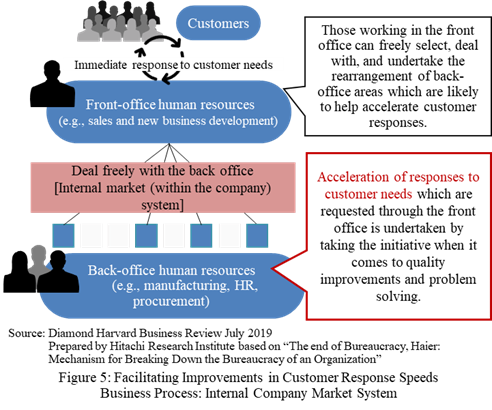
The Haier Group of China, the world’s largest consumer electronics manufacturer, has achieved higher profitability and corporate value than its competitors by reforming its old-fashioned management methods and transforming from a traditional bureaucratic organization to an autonomous, decentralized organization based on the shared value of the “Individualgoal combination (meaning closely aligning the value created for customers with the value received by employees).”
Since 2005, Haier has reduced its organizational hierarchy to three levels and has built an autonomous, decentralized organization consisting of a total of 4,000 microenterprises (ME) each comprised of 10 to 15 people. The delegating of authority when it comes to strategy development, recruitment of human resources, and wage and compensation allocation, serves to encourage voluntary collaboration among MEs. There are three types of MEs with each ME voluntarily collaborating with other MEs that have different roles to play in achieving their goals, thereby promoting efficiency.
✔User MEs: Around 200 exist. They are composed of front-office human resources. Example: While using the Web as the matrix for the consumer electronics business, actively ascertain customer needs and promote customer-oriented businesses (e.g., refrigerator business for young people in urban areas, etc.).
✔Incubating MEs: More than 50 exist. Promote entirely new businesses (e.g., loan securitization company Fintech Services, etc.).
✔Node MEs: Approximately 3,800 exist. Provides services for back-office functions such as the delivery of parts, design, manufacturing, R&D, legal affairs, human resources and finance.
The most distinctive feature of this organizational reform is the in-house market system [from in-house monopolies to in-house contracts] (Figure 5).
In most organizations, a significant percentage of employees are disconnected from market forces. Employees working in what are called back-office operations (HR, R&D, manufacturing, finance, IT, legal, etc.) essentially have an in-house monopoly. It is normal that no matter how inefficient these departments may be, other departments in the company are unable to discontinue dealings. At Haier, by contrast, any ME is free to decide whether to undertake dealings with other MEs. Each ME is required to voluntarily collaborate and create synergies with other MEs with different roles to achieve set revenue targets. The User ME involves a mechanism in which compensation changes in accordance with business performance in the market. A large part of the business performance of the Node ME is dependent on the performance of its client, the User ME. As such, salaries will be linked to market outcomes even in indirect departments. If there is concern that a user ME will not meet its goals, solutions to the issues are promptly considered with Node MEs. In the event of a major customer problem, multiple MEs work together across platforms to resolve the problem. As a result, each ME will band together for the goal of creating customer value and subsequently improve the quality of service provided by the Node MEs, thereby contributing to the increase of the speed of the entire organization and the generation of synergy. Each ME at Haier having freedom results in the disappearance of any beliefs to the effect that lukewarm efforts are acceptable when it comes to their responsibility to create value for customers.
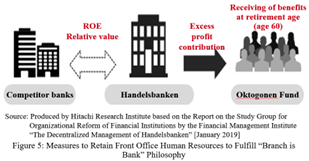
In addition, one of the challenges that Japanese companies are facing is that they are lagging behind other countries when it comes to the sense of achievement and job satisfaction that employees experience at their organizations (employee experience). According to “the State of Global Workplace 2022 Report” conducted by the Gallup U.S., it was found that North America (the U.S. and Canada) had the highest percentage of employees with strong levels of employee engagement at 33%. The global figure was 21%, while Japan ranked 128th out of 129 countries and regions surveyed with only 5%. According to “the World Happiness Report” published by the international research organization Sustainable Development Solutions Network (SDSN) in March 2023, Japan ranked 47th out of 137 countries in terms of happiness levels based on average scores over the past three years. Although this is a slight improvement from the 54th position among the 146 countries and regions in the previous year, the country still ranks the lowest among the G7 countries, which suggests that the low levels of engagement are affecting people in a broader sense in terms of their levels of happiness. The concept of employee engagement varies from company to company, but the METI’s vision for human resources of the future published in May 2022 defines the concept as “one that is used in the field of human resources to refer to a relationship wherein the directions of individual and organizational growth are linked and can contribute to each other.” It suggests that engagement increases when employees deepen their understanding and empathy when it comes to their company’s purpose and values as well as when they become motivated to contribute to achieving those elements. It also suggests that this drives company growth and productivity. When it comes to putting human capital management into practice to enhance employee engagement, it is important to achieve the enhancement of corporate value through the building of a unique management vision and business model, and to continue to retain front-office human resources over the long term.
Founded in 1871, Handelsbanken of Sweden is one of the leading commercial banks in Northern Europe. The bank has been undertaking management reform that will encourage the long-term retention of front-office human resources, along with strengthening customer engagement. Under the “Branch is Bank” management policy, the bank adopted a unique performance management system and incorporated decentralized management that was undertaken by delegating authority to branches in the 1970s . At that time, other major banks emphasized budgets and medium-term management plans. The bank does not pursue scale when it comes to loans and emphasizes customer satisfaction and efficiency in terms of branch operating costs. It also gives branch offices the discretion when it comes to hiring personnel as well as when it comes to sales strategies, credit decisions, and so on. Through these branch-driven management initiatives, which are aimed at having the bank become rooted in the local communities where it does business, the bank has consistently achieved stable profitability and higher ROE figures than its competitors. It is thoroughly believed that branch offices are the ones which know their local customers well, and when it comes to front-office human resources, the emphasis is placed on increasing the engagement of personnel who can provide long-term value. This is achieved by eliminating short-term quotas and retaining staff with business experience and sales capabilities in specific regions. First, as an environment to promote long-term retention, the bank adopts an HR system that is based on the assumption of a bank that is rooted in the community, where there are no transfers of staff between locations, and where there is lifetime employment. In terms of performance evaluations, the bank assigns KPIs (Key Performance Indicators), which serve to enhance customer engagement and efficiency, rather than the kinds of indicators one would see at other banks, such as the number of deposit accounts, investment products, and outstanding loans. The KPI shows customer satisfaction based on whether individuals serve as representatives for certain customers over the long term, and cost-income ratios, among others. In addition, the company has introduced the “Oktogonen Fund System” as a profit-sharing system to further motivate employees and encourage them to pursue cost efficiency. This is a system in which the bank contributes the equivalent of excess profit to a fund when its ROE exceeds the average ROE of its competitors. It is characterized by a “relative valuation” in which the contribution is made even when the banking industry as a whole is in decline as long as the ROE exceeds that of its competitors (Figure 6). Furthermore, as equity in the fund cannot be cashed until retirement (at the age of 60), it is one of the measures used to encourage long-term employment along with the pursuit of long-term profits together with customers.
The key points of measures serving to strengthen human capital as seen in the case of overseas companies are: (1) “generating synergy” by promoting cross-departmental collaboration to strengthen personnel with expertise that serve to accelerate the development of new services, (2) “improving responses” by undertaking the standardization/normalization of back-office operations in a manner which serves to strengthen customer-oriented human resources (which will be important in times such as when business models change), and (3) “enhancing retention” by undertaking long-term initiatives for the purpose of strengthening front-office human resources capable of providing long-term value to customers. This three-pronged approach will also lead to the need for other measures, such as the creation of teams consisting of people with diverse sets of expertise, the promotion of skill matching, the creation of mechanisms for employees to voluntarily streamline operations and improve customer responses, and the strengthening incentive systems that emphasize building long-term relationships with customers. Going forward, it will become increasingly important to analyze and confirm the correlation and causality between KPIs that affect corporate value (such as synergy generation, response improvement, and retention enhancement) and major KPIs related human capital (such as the diversification of human resources in the form of DE&I and engagement scores) based on each company’s specific business model, and to subsequently provide clarification as to which human capital enhancement efforts should be focused on. More than ever, there is a need to create management cycles (PDCA) driven by human resources data and subsequently make strategic investments in human capital which are aligned with the increase of corporate value.
✔Human Capital Management Study Group Report (Ito Report 2.0: Human Resources Version)
✔Diamond Harvard Business Review of July 2018 (“One Bank’s Agile Team Experiment: A Global Financial Group Has Transformed Itself with Agile Approaches”)
✔Diamond Harvard Business Review from July 2019 (“The end of Bureaucracy at Haier: Mechanism for Breaking Down the Bureaucracy of an Organization”)
✔Report on the Study Group for Organizational Reform of Financial Institutions by the Financial Management Institute (“The Decentralized Management of Handelsbanken”) [January 2019]
Kenichi Suzuki
Hitachi Research Institute
Chief Researcher, 1st Research Department
He is engaged in areas such as finance, management and governance research.
He assumed his current position after working in the Finance Department of the Research and Development Division in Hitachi, Ltd.
Naohiko Masuda
Hitachi Research Institute
Senior Researcher, 3rd Research Department
He is engaged in areas such as research on sustainable value creation and growth.
He assumed his current position after working at the Human Resources Department of Public and Social Division in Hitachi, Ltd.